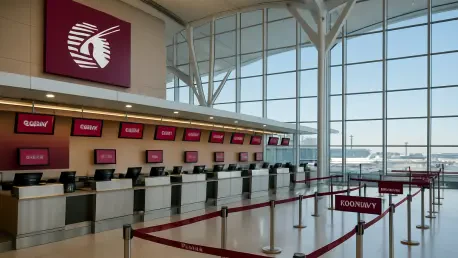In the ever-evolving landscape of global aviation, few announcements have stirred as much anticipation as Qatar Airways’ decision to relocate to The New Terminal One at John F. Kennedy International Airport (JFK). Imagine stepping into a world-class terminal, designed with cutting-edge technology and luxury in mind, as one of the world’s leading airlines sets a new benchmark for travel in New York City. This strategic shift, slated for next year, promises to redefine the passenger experience at one of the busiest airports in the United States. With a dedicated premium lounge and a focus on innovation, Qatar Airways is poised to elevate its presence in a key market, sparking curiosity about how this move will shape the future of air travel.
A Milestone Announcement for Qatar Airways
At a recent event, Qatar Airways revealed its plans to transition operations to The New Terminal One at JFK, marking a significant chapter in the airline’s expansion within the U.S. market. This relocation, set to occur in 2026, underscores the carrier’s dedication to delivering unparalleled service while reinforcing the importance of New York City as a cornerstone of its global network. The announcement, made with much fanfare, highlighted how this move aligns with the broader transformation of JFK into a modern aviation hub.
The event also shed light on the airline’s vision for enhancing the travel journey, with a strong emphasis on luxury and efficiency. Representatives from Qatar Airways emphasized that this step is not just about changing terminals but about creating an environment where passengers feel prioritized at every touchpoint. With millions of travelers passing through JFK annually, this development positions the airline to cater to a growing demand for premium experiences in a competitive landscape.
Spotlight on the Premium Lounge Debut
One of the most anticipated aspects of this relocation is the unveiling of Qatar Airways’ first dedicated lounge in the United States, a sprawling 15,000-square-foot space crafted for Business Class passengers. Attendees at the announcement event were given a glimpse into the lounge’s offerings, which include direct boarding gate access, VIP check-in counters, and an array of high-end amenities. From premium dining options to serene relaxation zones, every detail is designed to mirror the airline’s award-winning onboard service.
Additional features such as prayer rooms, children’s play areas, and duty-free shopping zones were also highlighted as key elements of the lounge. These additions cater to a diverse range of traveler needs, ensuring comfort and convenience before flights. Event speakers noted that this facility will set a new standard for airport lounges in the U.S., reflecting Qatar Airways’ commitment to excellence on the ground as well as in the air.
Collaboration with The New Terminal One
The event also showcased the strategic partnership between Qatar Airways and The New Terminal One, a collaboration rooted in a shared vision for innovation and customer satisfaction. Qatar Airways Group CEO Engr. Badr Mohammed Al-Meer spoke passionately about how this alliance will enhance the travel experience, bringing world-class service to one of the most iconic airports. His remarks underscored the mutual confidence in the terminal’s potential to support the airline’s growth ambitions in the American market.
Jennifer Aument, CEO of The New Terminal One, echoed these sentiments, describing the partnership as a testament to the terminal’s value for international carriers. Discussions at the event revealed how this collaboration will leverage modern infrastructure to create a seamless journey for passengers. This synergy between airline and terminal operator is expected to pave the way for other carriers to follow suit, amplifying JFK’s status as a global gateway.
Terminal Design and Passenger-Centric Features
A significant portion of the event focused on the architectural and technological advancements of The New Terminal One, which will serve as the backdrop for Qatar Airways’ enhanced services. The terminal boasts light-filled spaces and state-of-the-art systems designed to streamline every step of the travel process, from check-in to boarding. Presenters highlighted how these elements align with the airline’s focus on efficiency, ensuring travelers spend less time waiting and more time enjoying their journey.
The design philosophy behind the terminal prioritizes passenger engagement, creating an environment that feels both welcoming and intuitive. Event attendees learned how these features will complement Qatar Airways’ offerings, providing a cohesive experience that begins the moment a passenger steps into the airport. This focus on modern aesthetics and functionality is set to transform perceptions of air travel at JFK.
Broader Context of JFK’s Transformation
The announcement event also contextualized Qatar Airways’ relocation within the larger $19 billion redevelopment initiative at JFK, spearheaded by the Port Authority of New York and New Jersey. The New Terminal One stands as a cornerstone of this ambitious project, which includes constructing new terminals, modernizing existing facilities, and improving ground transportation networks. Speakers at the event emphasized how these upgrades will position JFK as a leading international hub over the coming years, from 2025 onward.
This comprehensive overhaul aims to address long-standing challenges at the airport, such as congestion and outdated infrastructure. By aligning with this transformation, Qatar Airways is not only enhancing its own operations but also contributing to a broader vision of aviation excellence. The event painted a picture of an airport reborn, with The New Terminal One playing a pivotal role in welcoming travelers from around the globe.
Reflecting on a Landmark Event
Looking back on the event, Qatar Airways’ announcement of its relocation to The New Terminal One at JFK stood as a defining moment in the airline’s U.S. journey. The detailed presentations and insightful remarks from industry leaders underscored the transformative potential of this move, both for passengers and for the airport’s future. It was a celebration of innovation, luxury, and strategic growth, setting a high bar for what travelers can expect in the years ahead.
As next steps, stakeholders are encouraged to focus on ensuring a smooth transition for the airline’s operations in 2026, prioritizing passenger communication and operational readiness. Beyond that, this development opens the door for further collaborations between airlines and modern terminals, potentially inspiring similar initiatives across other major airports. The aviation industry should take note, as this partnership could serve as a blueprint for balancing premium service with cutting-edge infrastructure, ultimately benefiting travelers worldwide.









